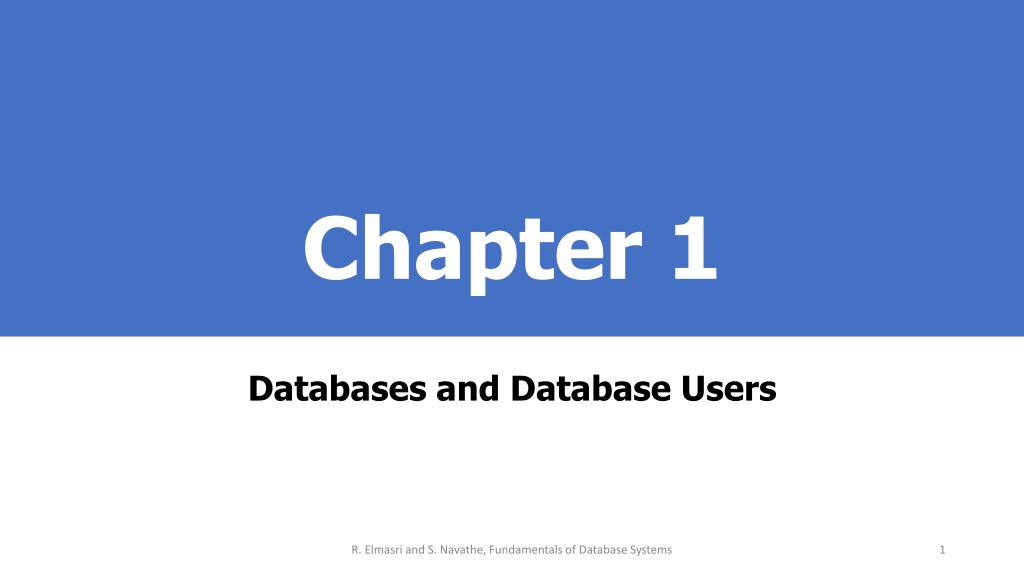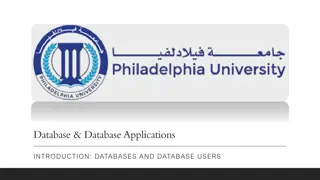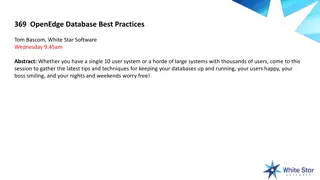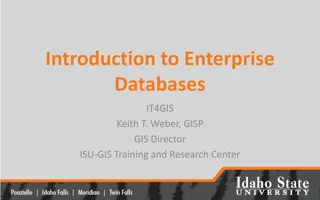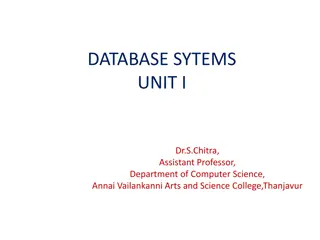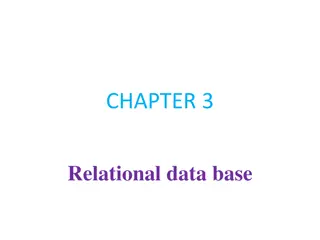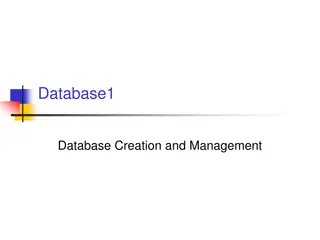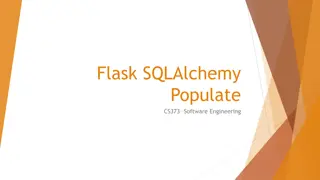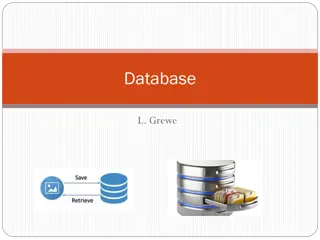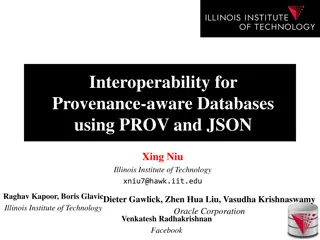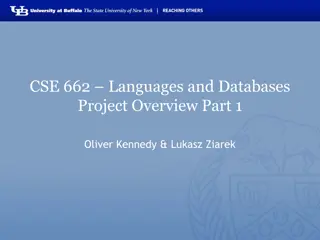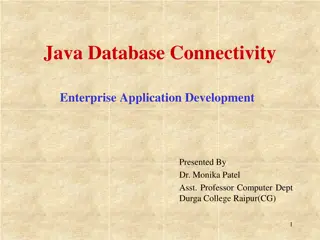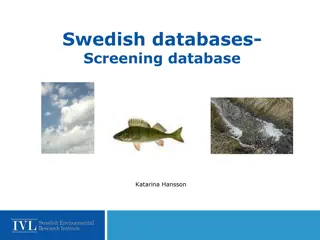Overview of Databases and Recent Developments in Database Systems
Explore the fundamentals of databases, including types, applications, users, and advantages. Learn about traditional and recent database applications, such as social networks, search engines, and emerging technologies like Big Data systems and NOSQL. Understand the concept of databases as a collection of related data and their significance in storing known facts. Delve into the main characteristics of the database approach and the various types of database users.
Download Presentation

Please find below an Image/Link to download the presentation.
The content on the website is provided AS IS for your information and personal use only. It may not be sold, licensed, or shared on other websites without obtaining consent from the author. Download presentation by click this link. If you encounter any issues during the download, it is possible that the publisher has removed the file from their server.
E N D
Presentation Transcript
Chapter 1 Databases and Database Users R. Elmasri and S. Navathe, Fundamentals of Database Systems 1
Outline Types of Databases and Database Applications Basic Definitions Typical DBMS Functionality Example of a Database (UNIVERSITY) Main Characteristics of the Database Approach Types of Database Users Advantages of Using the Database Approach R. Elmasri and S. Navathe, Fundamentals of Database Systems 2
What is a database A database is a collection of related data. Data refers to known facts that can be recorded and have an implicit meaning. Examples of data include; names, telephone numbers, social security numbers, emplids, and addresses of the people you may know. R. Elmasri and S. Navathe, Fundamentals of Database Systems 3
Types of Databases and Database Applications Traditional Database Applications Information that is stored and accessed is either textual or numeric Examples include CUNYfirst, Amazon, and hotel or airline reservation More Recent Database Applications: Multimedia Databases Geographic Information Systems (GIS) Biological and Genome Databases Data Warehouses Mobile databases Real-time and Active Databases In this course, we will only focus on traditional applications R. Elmasri and S. Navathe, Fundamentals of Database Systems 4
Recent Developments (1) Social Networks captures a lot of information about people and about communications among people-posts, tweets, photos, videos in systems such as: Facebook Twitter Linked-In Instagram YouTube All of the above constitutes data R. Elmasri and S. Navathe, Fundamentals of Database Systems 5
Recent Developments (2) Search Engines such Google, Bing, and Yahoo; collect their own repository of web pages for searching purposes R. Elmasri and S. Navathe, Fundamentals of Database Systems 6
Recent Developments (3) New Technologies are emerging from the so-called non-database software vendors to manage vast amounts of data generated on the web: Big Data storage systems involving large clusters of distributed computers NOSQL (Not Only SQL) systems A large amount of data now resides on the cloud which means it is in huge data centers using thousands of machines. R. Elmasri and S. Navathe, Fundamentals of Database Systems 7
Introductions and Basic Definitions (1) Database is a collection of related data. Mini-world: A database represents some aspect of the real world often called the miniworld or the universe of discourse (UoD). For example, student grades and transcripts at a university. Databases vary in size and complexity Database may be manual or computerized A computerized database are created and maintained either by application programs or a database management system (DBMS). R. Elmasri and S. Navathe, Fundamentals of Database Systems 8
Introductions and Basic Definitions (2) Database Management System (DBMS) is a software package/ system used to facilitate the creation and maintenance of a computerized database. Database System includes the DBMS software together with the data itself. Sometimes, the applications are also included. R. Elmasri and S. Navathe, Fundamentals of Database Systems 9
Simplified database system environment R. Elmasri and S. Navathe, Fundamentals of Database Systems 10
Functions of Typical DBMS (1) Defining a particular database by specifying its data types, structures, and constraints This database definition or descriptive information is also stored by the DBMS in the form of a database catalog or dictionary; it is called meta-data. Constructing or Loading the initial database contents on a secondary storage medium Database Manipulation: Retrieval: Querying, generating reports Modification: Insertions, deletions and updates to its content Accessing the database through Web applications Processing and Sharing by a set of concurrent users and application programs yet, keeping all data valid and consistent R. Elmasri and S. Navathe, Fundamentals of Database Systems 11
Additional Functions of DBMS Protection or Security measures to prevent unauthorized access Active processing to take internal actions on data Presentation and Visualization of data Maintenance of the database and associated programs over the lifetime of the database application Called database, software, and system maintenance R. Elmasri and S. Navathe, Fundamentals of Database Systems 12
Activities of Applications Against a Database Applications interact with a database by generating Queries: that access different parts of data and formulate the result of a request Transactions: that may read some data and update certain values or generate new data and store that in the database Applications must not allow unauthorized users to access data Applications must keep up with changing user requirements against the database R. Elmasri and S. Navathe, Fundamentals of Database Systems 13
Example of a Database (with a Conceptual Data Model) Mini-world for the example: Part of a UNIVERSITY environment. Some mini-world entities: STUDENTs COURSEs SECTIONs (of COURSEs) (academic) DEPARTMENTs INSTRUCTORs R. Elmasri and S. Navathe, Fundamentals of Database Systems 14
Example of a Database (with a Conceptual Data Model) Some mini-world relationships: SECTIONs are of specific COURSEs STUDENTs take SECTIONs COURSEs have prerequisite COURSEs INSTRUCTORs teach SECTIONs COURSEs are offered by DEPARTMENTs STUDENTs major in DEPARTMENTs R. Elmasri and S. Navathe, Fundamentals of Database Systems 15
Example of a Example of a simple simple database database R. Elmasri and S. Navathe, Fundamentals of Database Systems 16
Characteristics of the Database Approach Self-describing nature of a database system: A DBMS catalog stores the description of a particular database (e.g. data structures, types, and constraints) The description is called meta-data*. This allows the DBMS software to work with different database applications. Insulation between programs and data: Called program-data independence. Allows changing data structures and storage organization without having to change the DBMS access programs. R. Elmasri and S. Navathe, Fundamentals of Database Systems 17
Characteristics of the Database Approach (Continued) Data Abstraction: A data model is used to hide storage details and present the users with a conceptual view of the database. Programs refer to the data model constructs rather than data storage details Support of multiple views of the data: Each user may see a different view of the database, which describes only the data of interest to that user. R. Elmasri and S. Navathe, Fundamentals of Database Systems 18
Characteristics of the Database Approach (Continued) Sharing of data and multi-user transaction processing: Allowing a set of concurrent users to retrieve from and to update the database. Concurrency control within the DBMS guarantees that each transaction is correctly executed or aborted Recovery subsystem ensures each completed transaction has its effect permanently recorded in the database OLTP (Online Transaction Processing) is a major part of database applications. This allows hundreds of concurrent transactions to execute per second. R. Elmasri and S. Navathe, Fundamentals of Database Systems 19
Database Users Users may be divided into Those who actually use and control the database content, and those who design, develop and maintain database applications (called Actors on the Scene ), and Those who design and develop the DBMS software and related tools, and the computer systems operators (called Workers Behind the Scene ). R. Elmasri and S. Navathe, Fundamentals of Database Systems 20
Database Users Actors on the Scene Database administrators: Responsible for authorizing access to the database, for coordinating and monitoring its use, acquiring software and hardware resources, controlling its use and monitoring efficiency of operations. Database Designers: Responsible to define the content, the structure, the constraints, and functions or transactions against the database. They must communicate with the end-users and understand their needs. R. Elmasri and S. Navathe, Fundamentals of Database Systems 21
Database Users Actors on the Scene End-users: They use the data for queries, reports and some of them update the database content. End-users can be categorized into: Casual: access database occasionally when needed Na ve or Parametric: they make up a large section of the end-user population. They use previously well-defined functions in the form of canned transactions against the database. Users of Mobile Apps mostly fall in this category Bank-tellers or reservation clerks are parametric users who do this activity for an entire shift of operations. Social Media Users post and read information from websites R. Elmasri and S. Navathe, Fundamentals of Database Systems 22
Database Users Actors on the Scene Sophisticated: These include business analysts, scientists, engineers, others thoroughly familiar with the system capabilities. Many use tools in the form of software packages that work closely with the stored database. Stand-alone: Mostly maintain personal databases using ready-to-use packaged applications. An example is the user of a tax program that creates its own internal database. Another example is a user that maintains a database of personal photos and videos. R. Elmasri and S. Navathe, Fundamentals of Database Systems 23
Database Users Actors on the Scene System Analysts and Application Developers - This category currently accounts for a very large proportion of the IT work force. System Analysts: They understand the user requirements of na ve and sophisticated users and design applications including canned transactions to meet those requirements. Application Programmers: Implement the specifications developed by analysts and test and debug them before deployment. Business Analysts: There is an increasing need for such people who can analyze vast amounts of business data and real-time data ( Big Data ) for better decision making related to planning, advertising, marketing etc. R. Elmasri and S. Navathe, Fundamentals of Database Systems 24
Database Users Actors behind the Scene System Designers and Implementors: Design and implement DBMS packages in the form of modules and interfaces and test and debug them. The DBMS must interface with applications, language compilers, operating system components, etc. Tool Developers: Design and implement software systems called tools for modeling and designing databases, performance monitoring, prototyping, test data generation, user interface creation, simulation etc. that facilitate building of applications and allow using database effectively. Operators and Maintenance Personnel: They manage the actual running and maintenance of the database system hardware and software environment. R. Elmasri and S. Navathe, Fundamentals of Database Systems 25
Advantages of Using the Database Approach Controlling redundancy in data storage and in development and maintenance efforts. Sharing of data among multiple users. Restricting unauthorized access to data. Only the DBA staff uses privileged commands and facilities. Providing persistent storage for program Objects E.g., Object-oriented DBMSs make program objects persistent Providing Storage Structures (e.g. indexes) for efficient Query Processing R. Elmasri and S. Navathe, Fundamentals of Database Systems 26
Advantages of Using the Database Approach (continued) Providing optimization of queries for efficient processing. Providing backup and recovery services. Providing multiple interfaces to different classes of users. Representing complex relationships among data. Enforcing integrity constraints on the database. Drawing inferences and actions from the stored data using deductive and active rules and triggers. R. Elmasri and S. Navathe, Fundamentals of Database Systems 27
Additional Implications of Using the Database Approach Potential for enforcing standards: This is very crucial for the success of database applications in large organizations. Standards refer to data item names, display formats, screens, report structures, meta-data (description of data), Web page layouts, etc. Reduced application development time: Incremental time to add each new application is reduced. Flexibility to change data structures: Database structure may evolve as new requirements are defined. Availability of current information: Extremely important for on-line transaction systems such as shopping, airline, hotel, car reservations. R. Elmasri and S. Navathe, Fundamentals of Database Systems 28
Additional Implications of Using the Database Approach (Continued) Economies of scale: Wasteful overlap of resources and personnel can be avoided by consolidating data and applications across departments. R. Elmasri and S. Navathe, Fundamentals of Database Systems 29
Chapter Summary Types of Databases and Database Applications Basic Definitions Typical DBMS Functionality Example of a Database (UNIVERSITY) Main Characteristics of the Database Approach Types of Database Users Advantages of Using the Database Approach R. Elmasri and S. Navathe, Fundamentals of Database Systems 30
